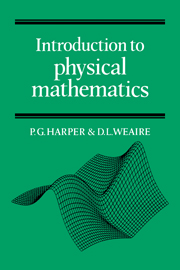Book contents
- Frontmatter
- Contents
- Preface
- Some notes on notation
- 1 Introduction
- 2 Errors
- 3 Cartesian coordinates
- 4 Vectors
- 5 The scalar product
- 6 The vector product and rotation
- 7 Matrices in physics
- 8 The transformation of matrices
- 9 The matrix eigenvalue equation
- 10 Exponential and logarithm functions
- 11 Sine and cosine functions
- 12 Graph plotting and curve sketching
- 13 Differentiation
- 14 Approximations
- 15 Power series and Taylor's expansion
- 16 Partial differentiation
- 17 Integration
- 18 The differential equation
- 19 Solving first-order differential equations
- 20 Second-order differential equations
- 21 Solving second-order differential equations
- 22 The complex exponential
- 23 The circuit equation
- 24 Harmonics and Fourier series
- 25 The diffusion equation
- 26 Waves
- 27 The rate of change of a vector
- 28 The scalar field and gradient operator
- 29 The vector field
- 30 Line integration
- 31 The potential field
- 32 Surface and volume integration
- 33 Flux and divergence
- 34 Circulation and the curl
- 35 Conclusion
- 36 Miscellaneous exercises
- Index
4 - Vectors
Published online by Cambridge University Press: 20 October 2009
- Frontmatter
- Contents
- Preface
- Some notes on notation
- 1 Introduction
- 2 Errors
- 3 Cartesian coordinates
- 4 Vectors
- 5 The scalar product
- 6 The vector product and rotation
- 7 Matrices in physics
- 8 The transformation of matrices
- 9 The matrix eigenvalue equation
- 10 Exponential and logarithm functions
- 11 Sine and cosine functions
- 12 Graph plotting and curve sketching
- 13 Differentiation
- 14 Approximations
- 15 Power series and Taylor's expansion
- 16 Partial differentiation
- 17 Integration
- 18 The differential equation
- 19 Solving first-order differential equations
- 20 Second-order differential equations
- 21 Solving second-order differential equations
- 22 The complex exponential
- 23 The circuit equation
- 24 Harmonics and Fourier series
- 25 The diffusion equation
- 26 Waves
- 27 The rate of change of a vector
- 28 The scalar field and gradient operator
- 29 The vector field
- 30 Line integration
- 31 The potential field
- 32 Surface and volume integration
- 33 Flux and divergence
- 34 Circulation and the curl
- 35 Conclusion
- 36 Miscellaneous exercises
- Index
Summary
The latest VTOL (vertical take-off and landing) aircraft are described in the press as having ‘vectored thrust’. The jet can indeed be rotated relative to the aircraft so as to produce an orientated propelling force. In less newsworthy applications, physicists and engineers have been dealing with vectored thrust for a century or so, and in an immense variety of situations.
But it is not the only force that is vectored. The term vector may refer to any directed quantity, the most elementary instance being the geometrical displacement in the previous chapter. When dealing with vectors, ordinary numbers are called scalars. In physics all vector quantities are ultimately related to displacements, so it is both convenient and sufficient to single them out for discussion. The displacement (x, y, z) from the origin, or from any point, has a magnitude and a direction. Attending first to the x-direction (the axes, remember, are arbitrary, but have usually been chosen to simplify some geometry), then the displacement (1,0,0) is called the unit vector in the x-direction. It is denoted by the single bold-face symbol i. Positive or negative multiples of i can be added in any order to give a larger or smaller displacement along the x-axis. The rule is: multiplying a vector by a scalar changes its magnitude by the same factor and multiplying by – 1 reverses its direction (see fig. 4.1).
- Type
- Chapter
- Information
- Introduction to Physical Mathematics , pp. 23 - 28Publisher: Cambridge University PressPrint publication year: 1985



